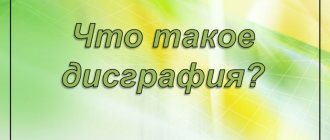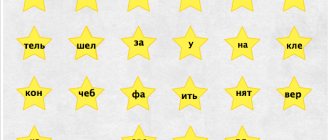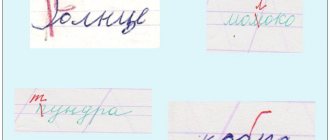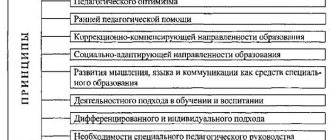When a child begins to study in primary school, parents may be surprised to learn from the teacher that their child is experiencing serious difficulties with writing. Quite often, a new student makes many specific mistakes when writing words and, despite all his efforts, completes written assignments extremely slowly and sloppily. This is how a specific speech therapy pathology manifests itself – dysgraphia.
How to understand that a child has dysgraphia?
At its core, dysgraphia is a fairly common speech therapy defect in which written speech is impaired. This deviation is diagnosed in almost 30% of students. The presence of pathology in younger schoolchildren is associated with insufficient maturity of the mental system, as well as with a lack of consistency in the functioning of the brain lobes, which are responsible for the perception of information and fine motor skills of the hands.
Most often, the presence of dysgraphia is detected precisely at the beginning of schooling, when purposeful mastery of these skills occurs. In copybooks, the child makes phonetic errors of various types.
For example, it does not distinguish between letters that sound similar (“z” and “s”, “zh” and “sh”, “t” and “d”), adds unnecessary ones or skips necessary ones (“vesena” instead of “spring”, “trlka” " instead of "plate"), writes words together, etc.
At first, looking at the work of such a student, the teacher can conclude that he is lazy, irresponsible or illiterate. However, the reason lies much deeper. Such children diligently approach the task, however, for certain reasons, they cannot cope with the correct spelling of words.
For example, if we compare the mistakes of two students in writing the word “sentence”, then a child with simple ignorance of grammatical rules will write “addition”, and a child with dysgraphia will write “branching”. It is in such nuances that the presence of this pathology is visible.
Moreover, as a rule, dysgraphics are written very sloppy and crookedly. No matter how hard they try, they cannot keep up with their faster classmates, which causes constant irritability, dissatisfaction, depressed mood and low self-esteem. Moreover, quite often dysgraphia is supplemented by dyslexia (difficulties with reading) and speech disorders.
Causes and symptoms of dysgraphia
There are five forms of dysgraphia, which are rarely found in their pure form; they are mostly mixed:
- Acoustic – resulting from impairments in sound recognition.
- Articulatory-acoustic – manifests itself due to disturbances in articulation and phonemic perception.
- Agrammatical – problems in lexical development and grammar development.
- Optical – with undeveloped visual-spatial perception.
- A special form caused by disturbances in language synthesis.
The symptoms of dysgraphia are mostly similar - these are errors in writing that are not associated with ignorance of the rules. A child with dysgraphia misses and confuses letters and syllables, can write words together, and confuse endings and forms. Handwriting suffers, and writing speed is also low.
There are also common symptoms - lack of attention, inability to concentrate on one thing for a long time, poor memory.
Main types of dysgraphia
Based on the characteristics of written disorders, experts identify five main types of dysgraphia. Let's take a closer look at how each of them manifests itself.
Acoustic dysgraphia
The child pronounces words correctly and does not experience hearing difficulties, however, when displaying information on paper, he replaces letters with ones that sound similar to them. These can be vowels or consonants, voiced or unvoiced, hissing or whistling. The student may also have difficulty representing letters correctly in soft form.
For example: “dikdand” - “dictation”, “masina” - “car”, “syplenok” - “chicken”, as well as “lublu” - “love”, “frock coat” - “frock coat”.
Articular-acoustic dysgraphia
Problems with spelling words are the result of incorrect pronunciation. A child who has speech therapy defects and makes mistakes during a conversation cannot correctly transfer sounds onto paper. That is, as the student speaks, so he writes. Accordingly, if the baby has incorrect pronunciation, then the spelling will be the same. For example: “lyba” - “fish”, “labota” - “work”, “zayas” - “hare”, “sapka” - “hat”, “nasa skola” - “our school”.
Optical dysgraphia
The child has difficulty visually representing written characters. The student can assign additional details, loops, ticks or hooks to the letters, or lose the necessary elements. Mirror spelling of letters is also quite often observed, especially in cases where the student is left-handed.
Example: most often a child confuses the spelling of similar letters “i” - “sh”, “o” - “a”, loses elements of the symbols “” - “A” or displays them in a mirror image “E” - “Z”.
Dysgraphia. Diagnostics and correction in tables; methodological development in speech therapy on the topic
Slide 1
School of a young speech therapist “Planning work to correct various forms of dysgraphia” Kalininsky district 02/14/11 State Educational Institution TsPMSS Compiled by: Selyavina I.B.
Slide 2
Methodological recommendations Efimenkova L. N. Correction of oral and written speech of primary school students. – M., “Enlightenment”, 1991. Sadovnikova I. N. Impairments in written speech and their overcoming in primary schoolchildren. – M., “Vlados”, 1997. Lalaeva R.I. Speech therapy work in correctional classes. - M., “Vlados”, 1998 Yakovleva N.N. Correction of written speech disorders. - St. Petersburg, “Karo”, 2007. Mazanova E.V. Speech therapy. Dysgraphia caused by a violation of language analysis and synthesis. – M., 2006 Lopatina L.V., etc. Speech therapy diagnostics and correction of speech disorders in children. Yastrebova A.V. Correction of speech impairment in secondary school students. – M., “Enlightenment”, 1984.
Slide 3
Planning work to correct violations of language analysis and synthesis: Vowel sounds and letters: - articulation of sound - characteristics of sound - isolation of sound from the background: sounds, syllables, words, sentences and in the text. -differentiation of sounds and letters. Consonant sounds and letters: -articulation of sound -characteristics of sound -selection of sound against the background: sound, syllable, word, sentence, in the text. -differentiation of sounds and letters.
Slide 4
Planning work to correct violations of language analysis and synthesis: Syllabic analysis of words: analysis of words with one syllable (SGS, SSGS, SGSS) analysis of words with two syllables (SGSG, GHA) analysis of words with two syllables (GSGS) analysis of words with three or more syllables (SSSGSG, etc.) Analysis and synthesis of sentences. A simple uncommon, common sentence without a preposition. Drawing up a proposal outline. Spreading sentences using verbs, adjectives, prepositions. Drawing up a proposal outline. Text analysis . Composing text from sentences. Working with deformed text.
Slide 5
Planning work to correct violations of phonemic analysis and synthesis. Vowel sounds and letters. Articulation, isolating a sound against the background of a syllable, word, sentence, differentiating sounds and letters. Consonant sounds and letters. Hard and soft, dull and voiced consonants. Differentiation of sounds and letters. Yotated vowels. Indication of softness of consonants by iotized vowels and a soft sign. Differentiation of iotated vowels. Development and improvement of the skills of sound-letter analysis and word synthesis.
Slide 6
Planning work to correct grammatical violations. Clarification and expansion of the dictionary. Development and improvement of word formation and inflection skills. 3. Working with prepositions. Development of coordination and management skills.
Slide 7
Planning work to correct optical disorders. Development and formation of spatial and temporal concepts. Development of constructive praxis. Development of mnestic ideas. Development of graphomotor skills and abilities. Development of skills in sound-letter analysis and synthesis. Differentiation of mixed letters.
Slide 8
Table for diagnosis and correction of various types of dysgraphia. Types of dysgraphia errors Ways of correction Optical dysgraphia 1. Violation of the spatial arrangement of letters. "Mirror Letter" 2. Omission and replacement of elements of letters: O-a, i-u, y-i-a, y-b, x-zh, k-n, l-m, p-t, P-T-G-R, i-sh, sh-sh-ts, b-d, v-d, 1. Formation of spatial and temporal representations. 2. Development of constructive praxis. 3. Development of mnestic ideas. 4.Development of skills in sound-letter analysis and synthesis.
Slide 9
Table for diagnosis and correction of various types of dysgraphia. Types of dysgraphia errors Ways of correction Dysgraphia due to violations of phonemic analysis and synthesis 1. Replacement of vowels: o-a, o-u, s-i, a-ya, o-yo, u-yu, e-e, e-yu 2. Replacement of consonant letters: b-p, d-t, k-g, s-z, sh-zh, v-f, ts-s, sh-sch, ch-sch, ch-t, ts-ts. 1. Development and improvement of phonemic representations. 2.Development of the skill of sound-letter analysis and synthesis.
Slide 10
Table for diagnosis and correction of various types of dysgraphia. Types of dysgraphia errors Ways of correction Dysgraphia due to violations of language analysis and synthesis 1. Omissions of vowels and consonants. 2.Omissions, permutations of syllables, contamination and perseveration. 3. Failure to respect supply boundaries. 1. Development and formation of phonemic representations. 2. Development of the skill of syllabic analysis and synthesis. 3.Analysis and synthesis of sentences and texts.
Slide 11
Table for diagnosis and correction of various types of dysgraphia. Types of dysgraphia errors Ways of correction Agrammatic dysgraphia 1. Inaccuracy in the use of words. 2. Incorrect spelling of word endings. 3. Incorrect use of prefixes and prepositions. 4. Incorrect selection of test and cognate words. 5. Violation of the agreement of words in a sentence. 1. Clarification and expansion of the dictionary. Development and improvement of word formation and inflection skills. 3. Working with prepositions. 4.Analysis and synthesis of sentences and texts.
Is it possible to eliminate dysgraphia in a child?
Dysgraphia is a defect that can be corrected. Children with this pathology successfully develop, grow up and achieve success. This can be confirmed by famous people who were diagnosed with dysgraphia in childhood, including Albert Einstein, Walt Disney, Marilyn Monroe, Vladimir Mayakovsky and many others.
The key task of the parents of such a child is to attract a competent speech therapist-defectologist to solve this problem. A correction course is developed after determining the type of dysgraphia and the severity of the pathology. The speech therapist creates exercises that allow you to compensate for defects in the pronunciation of sounds, correct speech, form the recognition of sounds and letters, develop motor skills and other mental functions of the child.
Date of publication: 02/25/2019. Last modified: 05/05/2021.
Diagnosis of dysgraphia
The diagnosis of dysgraphia is made by a speech therapist after communicating with the child and a series of written tests. The student is asked to write a dictation, rewrite text printed and handwritten, read, and make a written description of the picture. In addition to the speech therapist, it is necessary to show the child to other specialists: an ENT specialist, an ophthalmologist, a neurologist.
Based on the conclusions of doctors and written tests, a conclusion is made and the type and severity of dysgraphia is determined.
Correction and correction of dysgraphia at a speech therapy center in Moscow
Dysgraphia cannot be corrected using a school curriculum ; special classes with a speech therapist, physical therapy, and home exercises will be needed. Corrective work on dysgraphia is built individually with each student, since problems with writing can be different, as well as the child’s reaction to corrective classes.
To correct dysgraphia, a speech therapist develops a system for filling gaps that are important for developing writing skills. Additionally, work is being done to develop speech, expand vocabulary, improve attention and memory.
Physical therapy and games with magnet letters are allowed, especially for preschoolers and primary schoolchildren.
Our specialists will help eliminate errors in a child’s writing, expand vocabulary, develop speech hearing, train auditory attention and auditory-speech memory.
Article by speech therapist-psychologist T.B. Zukor
Dysgraphia is a complex of specific disorders of writing function in humans.
How to understand that a child has dysgraphia? A simple example. Your child starts school, and over time you notice that he has difficulties with writing. Most often, this is discovered when completing tasks in the Russian language, and at the same time, the student can demonstrate success in mathematics. Many parents begin to scold their child, forcing them to rewrite the exercise several times, but do not get the desired result. If you notice that there is some consistency or specificity in your child’s mistakes, then perhaps we are talking about dysgraphia.








